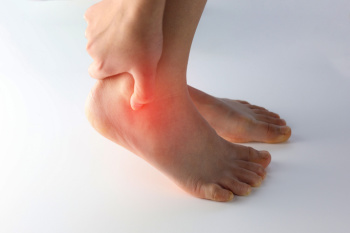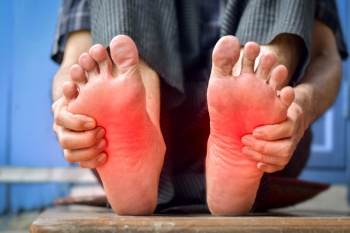

Achilles tendon injuries represent a common ailment affecting individuals engaged in physical activities, particularly athletes. The Achilles tendon is a robust band of tissue connecting the calf muscles to the heel bone. This tendon facilitates essential movements such as walking, running, and jumping. Symptoms of Achilles tendon injuries typically include pain and stiffness at the back of the heel, aggravated during physical exertion or when climbing stairs. Swelling and tenderness along the tendon often accompany these symptoms, indicating potential damage. The name Achilles tendon injury originates from the legendary Greek hero Achilles, who was known for his invincibility in battle except for his heel, which was his lone vulnerable spot. This historical reference underscores the vulnerability of the Achilles tendon to injury, emphasizing the significance of its proper care and treatment. Understanding the definition, symptoms, and origin of Achilles tendon injuries empowers individuals to recognize and address these issues promptly, promoting optimal recovery and prevention strategies. If you have endured this type of injury, it is suggested that you promptly consult a podiatrist who can accurately diagnose and treat this condition.
Achilles tendon injuries need immediate attention to avoid future complications. If you have any concerns, contact Dr. Sybil J. Fisher of Texas. Our doctor can provide the care you need to keep you pain-free and on your feet.
What Is the Achilles Tendon?
The Achilles tendon is a tendon that connects the lower leg muscles and calf to the heel of the foot. It is the strongest tendon in the human body and is essential for making movement possible. Because this tendon is such an integral part of the body, any injuries to it can create immense difficulties and should immediately be presented to a doctor.
What Are the Symptoms of an Achilles Tendon Injury?
There are various types of injuries that can affect the Achilles tendon. The two most common injuries are Achilles tendinitis and ruptures of the tendon.
Achilles Tendinitis Symptoms
Rupture Symptoms
Treatment and Prevention
Achilles tendon injuries are diagnosed by a thorough physical evaluation, which can include an MRI. Treatment involves rest, physical therapy, and in some cases, surgery. However, various preventative measures can be taken to avoid these injuries, such as:
If you have any questions please feel free to contact one of our offices located in Houston and Sugar Land, TX . We offer the newest diagnostic tools and technology to treat your foot and ankle needs.

Tarsal tunnel syndrome, often likened to carpal tunnel syndrome in the wrist, is a condition that affects the feet and ankles. The tarsal tunnel is a narrow passageway on the inner side of the ankle, encased by bone and tissue, through which nerves and blood vessels pass. When this tunnel becomes compressed or squeezed, it can lead to tarsal tunnel syndrome. Symptoms can include a burning pain, tingling, or numbness in the inner ankle, heel, or sole of the foot. If left untreated, the condition can worsen, leading to weakness and muscle deterioration in the affected area. Several factors can contribute to tarsal tunnel syndrome, including injury, inflammation, or structural abnormalities in the foot. Diagnosing the condition involves a thorough examination by a podiatrist, often including imaging tests to rule out other potential causes. If you have pain as described above, it is suggested that you schedule an appointment with a podiatrist who can accurately diagnose and treat tarsal tunnel syndrome.
Tarsal tunnel syndrome can be very uncomfortable to live with. If you are experiencing tarsal tunnel syndrome, contact Dr. Sybil J. Fisher of Texas. Our doctor can provide the care you need to keep you pain-free and on your feet.
Tarsal Tunnel Syndrome
Tarsal tunnel syndrome, which can also be called tibial nerve dysfunction, is an uncommon condition of misfiring peripheral nerves in the foot. The tibial nerve is the peripheral nerve in the leg responsible for sensation and movement of the foot and calf muscles. In tarsal tunnel syndrome, the tibial nerve is damaged, causing problems with movement and feeling in the foot of the affected leg.
Common Cause of Tarsal Tunnel Syndrome
The Effects of Tarsal Tunnel Syndrome
A physical exam of the leg can help identify the presence of tarsal tunnel syndrome. Medical tests, such as a nerve biopsy, are also used to diagnose the condition. Patients may receive physical therapy and prescriptive medication. In extreme cases, some may require surgery.
If you have any questions please feel free to contact one of our offices located in Houston and Sugar Land, TX . We offer the newest diagnostic and treatment technologies for all your foot and ankle needs.

Flat feet, a condition where the arches of the feet touch or nearly touch the ground, can be a source of discomfort and may affect daily activities. Understanding the causes and symptoms is vital for those grappling with this common foot ailment. Often, flat feet are hereditary, with genetic factors contributing to the lack of arch development. Tendon or ligament issues, arising from injury or overuse, can also lead to flat feet. Rheumatoid arthritis or conditions impacting the nervous system may alter foot structure, causing the arches to collapse. Symptoms include pain or discomfort along the inner side of the ankle, swelling on the bottom of the feet, and difficulty in standing on tiptoes. Recognizing these signs prompts individuals to seek appropriate interventions, such as wearing supportive footwear or orthotic devices. If you have flat feet, it is suggested that you consult a podiatrist who can guide you toward effective relief options.
Flatfoot is a condition many people suffer from. If you have flat feet, contact Dr. Sybil J. Fisher from Texas. Our doctor will treat your foot and ankle needs.
What Are Flat Feet?
Flatfoot is a condition in which the arch of the foot is depressed and the sole of the foot is almost completely in contact with the ground. About 20-30% of the population generally has flat feet because their arches never formed during growth.
Conditions & Problems:
Having flat feet makes it difficult to run or walk because of the stress placed on the ankles.
Alignment – The general alignment of your legs can be disrupted, because the ankles move inward which can cause major discomfort.
Knees – If you have complications with your knees, flat feet can be a contributor to arthritis in that area.
Symptoms
Treatment
If you are experiencing pain and stress on the foot you may weaken the posterior tibial tendon, which runs around the inside of the ankle.
If you have any questions please feel free to contact one of our offices located in Houston and Sugar Land, TX . We offer the newest diagnostic and treatment technologies for all your foot and ankle needs.

Foot arthritis can significantly impact mobility and quality of life, but incorporating targeted exercises into your daily routine can help alleviate discomfort and improve joint function. Toe curls, where you scrunch a towel or small object with your toes, can strengthen the muscles in your feet and toes, providing better support for arthritic joints. Ankle circles involve gently rotating your ankles in clockwise and counterclockwise motions to improve flexibility and reduce stiffness. Additionally, seated calf stretches and toe stretches can help improve range of motion and reduce tension in the foot and ankle joints. Walking in a swimming pool or performing water aerobics can provide low-impact exercise, while reducing stress on arthritic joints. Incorporating some of these exercises into your routine can help manage foot arthritis symptoms. If you have arthritis and your feet are affected, it is strongly suggested that you are under the care of a podiatrist who can help you to manage this condition.
Arthritis can be a difficult condition to live with. If you are seeking treatment, contact Dr. Sybil J. Fisher from Texas. Our doctor can provide the care you need to keep you pain-free and on your feet.
Arthritic Foot Care
Arthritis is a term that is commonly used to describe joint pain. The condition itself can occur to anyone of any age, race, or gender, and there are over 100 types of it. Nevertheless, arthritis is more commonly found in women compared to men, and it is also more prevalent in those who are overweight. The causes of arthritis vary depending on which type of arthritis you have. Osteoarthritis for example, is often caused by injury, while rheumatoid arthritis is caused by a misdirected immune system.
Symptoms
Arthritic symptoms range in severity, and they may come and go. Some symptoms stay the same for several years but could potentially get worse with time. Severe cases of arthritis can prevent its sufferers from performing daily activities and make walking difficult.
Risk Factors
If you suspect your arthritis is affecting your feet, it is crucial that you see a podiatrist immediately. Your doctor will be able to address your specific case and help you decide which treatment method is best for you.
If you have any questions, please feel free to contact one of our offices located in Houston and Sugar Land, TX . We offer the newest diagnostic and treatment technologies for all your foot care needs.
Copyright © 2016 S.J. Fisher DPM | Site Map | Design by: Podiatry Content Connection